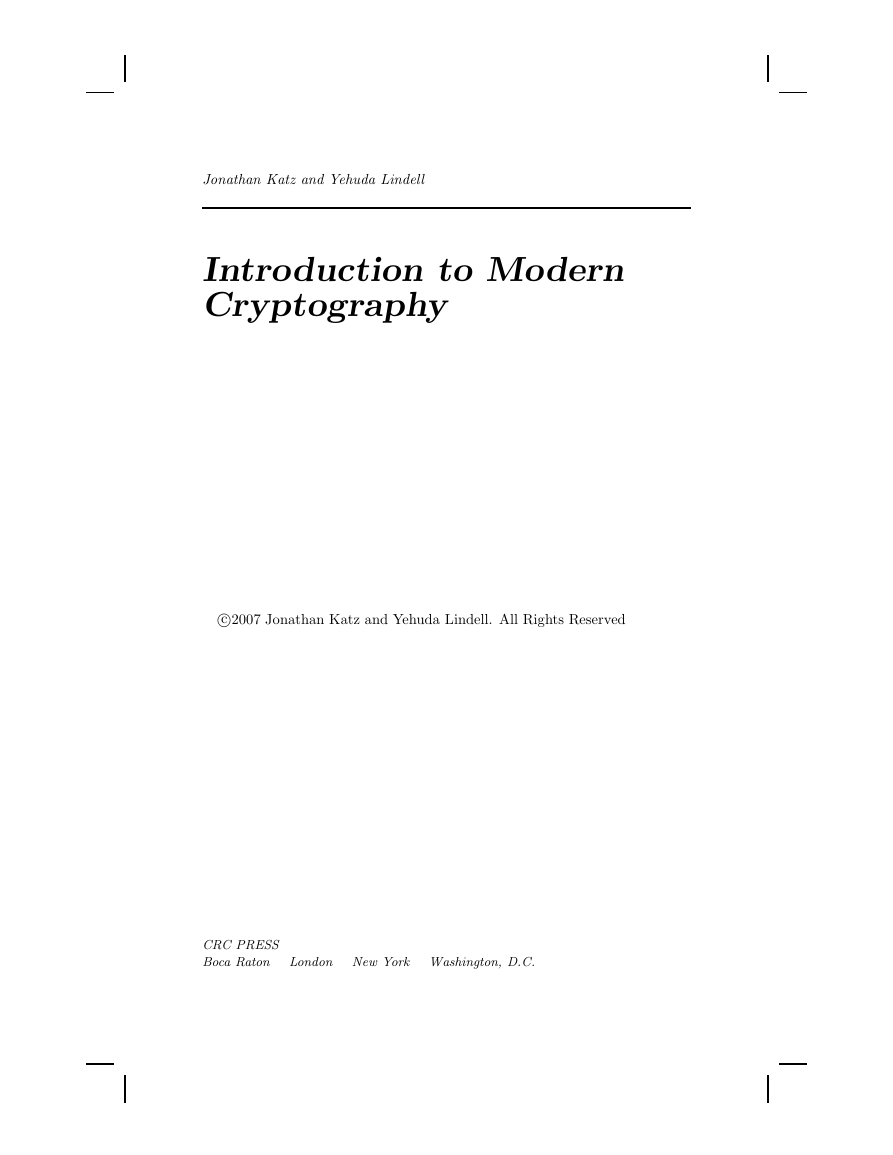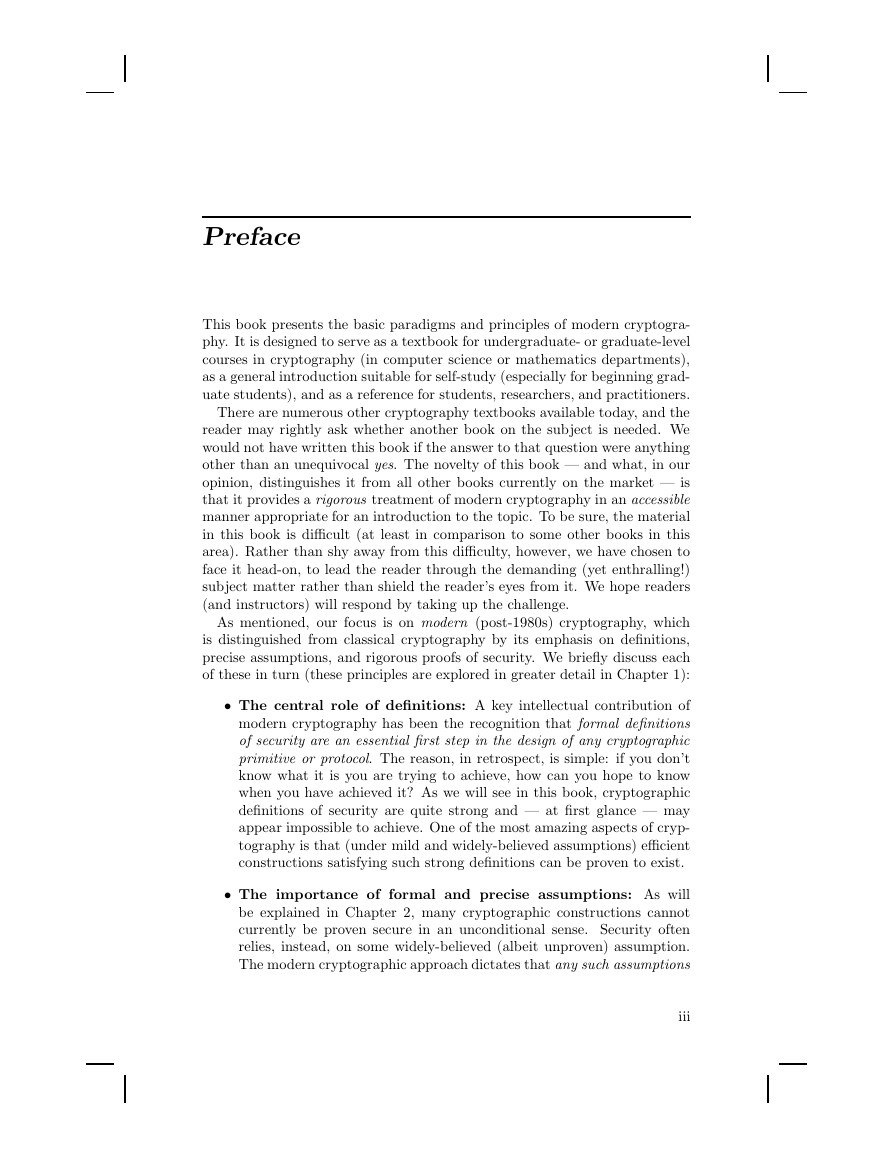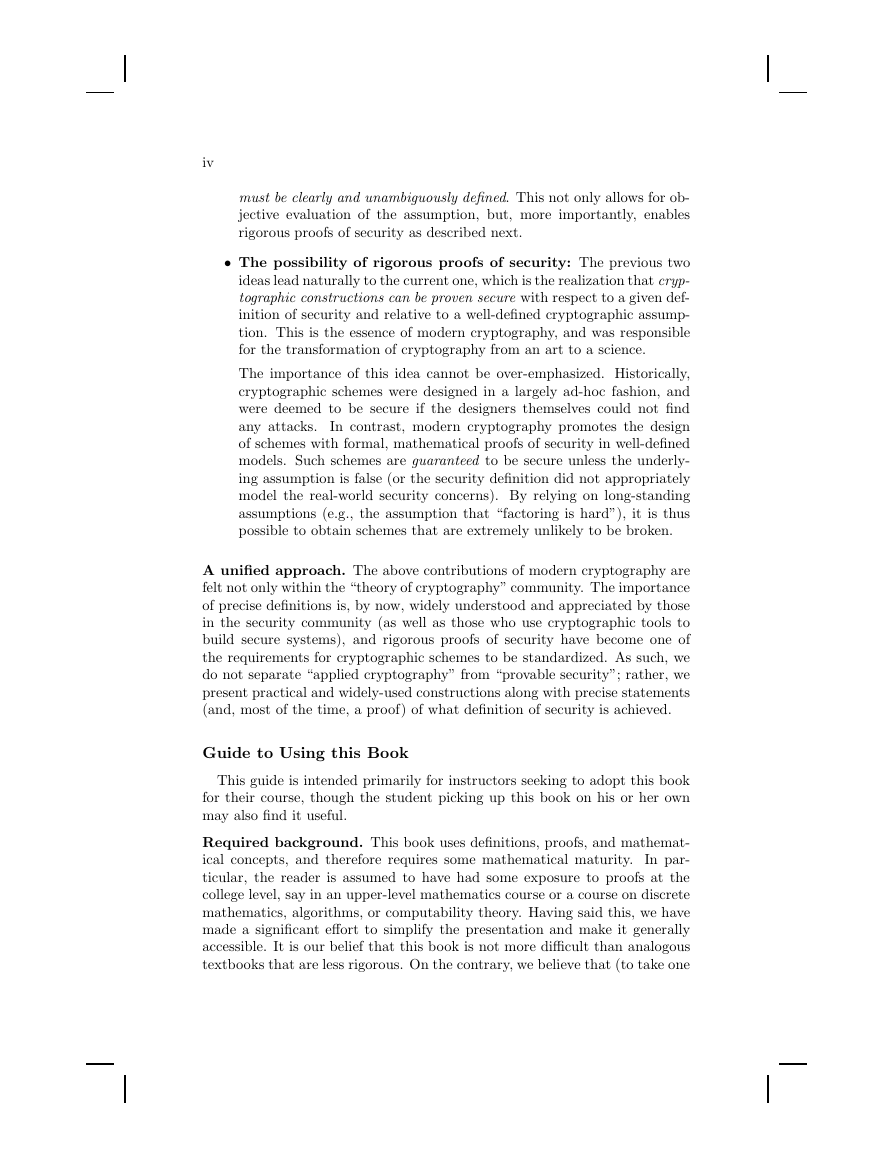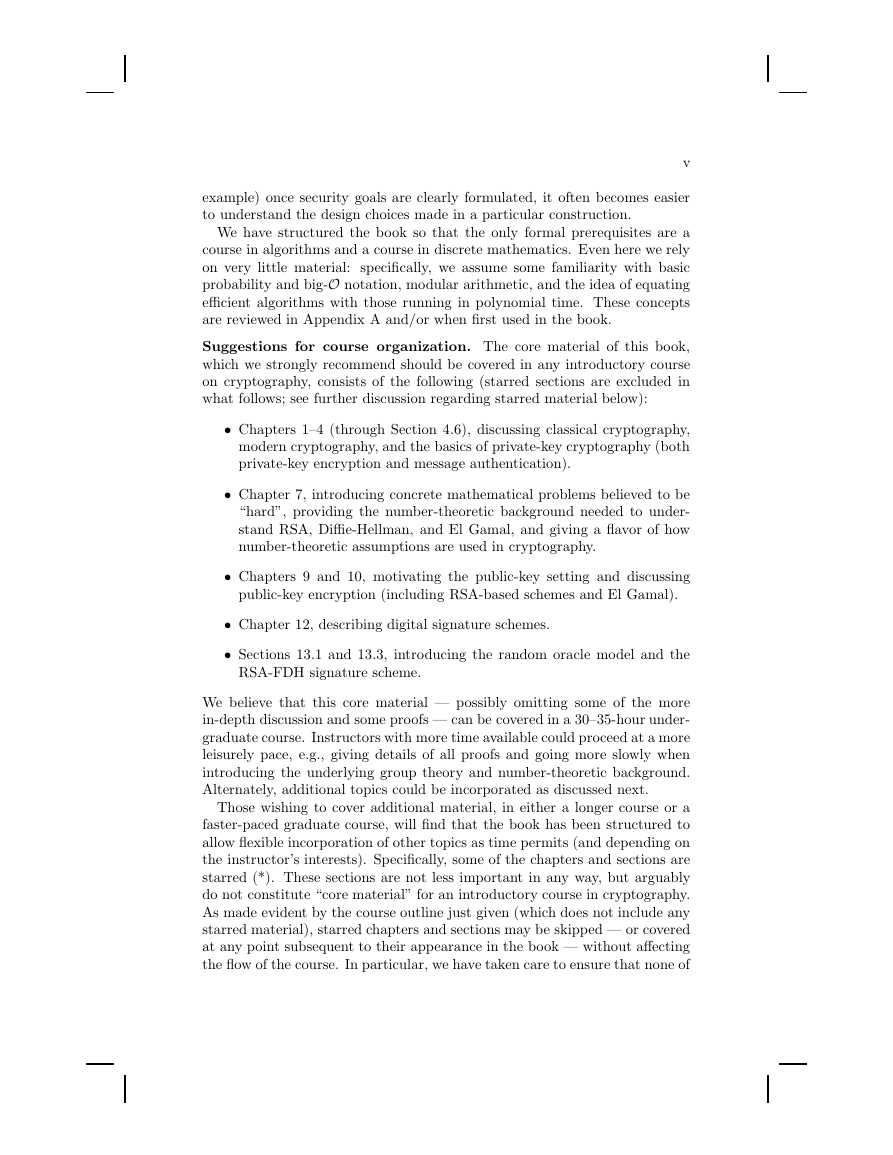Jonathan Katz and Yehuda Lindell
Introduction to Modern
Cryptography
c2007 Jonathan Katz and Yehuda Lindell. All Rights Reserved
CRC PRESS
Boca Raton
London New York Washington, D.C.
�
�
Preface
This book presents the basic paradigms and principles of modern cryptogra-
phy. It is designed to serve as a textbook for undergraduate- or graduate-level
courses in cryptography (in computer science or mathematics departments),
as a general introduction suitable for self-study (especially for beginning grad-
uate students), and as a reference for students, researchers, and practitioners.
There are numerous other cryptography textbooks available today, and the
reader may rightly ask whether another book on the subject is needed. We
would not have written this book if the answer to that question were anything
other than an unequivocal yes. The novelty of this book | and what, in our
opinion, distinguishes it from all other books currently on the market | is
that it provides a rigorous treatment of modern cryptography in an accessible
manner appropriate for an introduction to the topic. To be sure, the material
in this book is dicult (at least in comparison to some other books in this
area). Rather than shy away from this diculty, however, we have chosen to
face it head-on, to lead the reader through the demanding (yet enthralling!)
subject matter rather than shield the reader’s eyes from it. We hope readers
(and instructors) will respond by taking up the challenge.
As mentioned, our focus is on modern (post-1980s) cryptography, which
is distinguished from classical cryptography by its emphasis on denitions,
precise assumptions, and rigorous proofs of security. We briey discuss each
of these in turn (these principles are explored in greater detail in Chapter 1):
The central role of denitions: A key intellectual contribution of
modern cryptography has been the recognition that formal denitions
of security are an essential rst step in the design of any cryptographic
primitive or protocol. The reason, in retrospect, is simple: if you don’t
know what it is you are trying to achieve, how can you hope to know
when you have achieved it? As we will see in this book, cryptographic
denitions of security are quite strong and | at rst glance | may
appear impossible to achieve. One of the most amazing aspects of cryp-
tography is that (under mild and widely-believed assumptions) ecient
constructions satisfying such strong denitions can be proven to exist.
The importance of formal and precise assumptions: As will
be explained in Chapter 2, many cryptographic constructions cannot
currently be proven secure in an unconditional sense. Security often
relies, instead, on some widely-believed (albeit unproven) assumption.
The modern cryptographic approach dictates that any such assumptions
iii
�
iv
must be clearly and unambiguously dened. This not only allows for ob-
jective evaluation of the assumption, but, more importantly, enables
rigorous proofs of security as described next.
The possibility of rigorous proofs of security: The previous two
ideas lead naturally to the current one, which is the realization that cryp-
tographic constructions can be proven secure with respect to a given def-
inition of security and relative to a well-dened cryptographic assump-
tion. This is the essence of modern cryptography, and was responsible
for the transformation of cryptography from an art to a science.
The importance of this idea cannot be over-emphasized. Historically,
cryptographic schemes were designed in a largely ad-hoc fashion, and
were deemed to be secure if the designers themselves could not nd
any attacks.
In contrast, modern cryptography promotes the design
of schemes with formal, mathematical proofs of security in well-dened
models. Such schemes are guaranteed to be secure unless the underly-
ing assumption is false (or the security denition did not appropriately
model the real-world security concerns). By relying on long-standing
assumptions (e.g., the assumption that \factoring is hard"), it is thus
possible to obtain schemes that are extremely unlikely to be broken.
A unied approach. The above contributions of modern cryptography are
felt not only within the \theory of cryptography" community. The importance
of precise denitions is, by now, widely understood and appreciated by those
in the security community (as well as those who use cryptographic tools to
build secure systems), and rigorous proofs of security have become one of
the requirements for cryptographic schemes to be standardized. As such, we
do not separate \applied cryptography" from \provable security"; rather, we
present practical and widely-used constructions along with precise statements
(and, most of the time, a proof) of what denition of security is achieved.
Guide to Using this Book
This guide is intended primarily for instructors seeking to adopt this book
for their course, though the student picking up this book on his or her own
may also nd it useful.
Required background. This book uses denitions, proofs, and mathemat-
ical concepts, and therefore requires some mathematical maturity.
In par-
ticular, the reader is assumed to have had some exposure to proofs at the
college level, say in an upper-level mathematics course or a course on discrete
mathematics, algorithms, or computability theory. Having said this, we have
made a signicant eort to simplify the presentation and make it generally
accessible. It is our belief that this book is not more dicult than analogous
textbooks that are less rigorous. On the contrary, we believe that (to take one
�
v
example) once security goals are clearly formulated, it often becomes easier
to understand the design choices made in a particular construction.
We have structured the book so that the only formal prerequisites are a
course in algorithms and a course in discrete mathematics. Even here we rely
on very little material: specically, we assume some familiarity with basic
probability and big-O notation, modular arithmetic, and the idea of equating
ecient algorithms with those running in polynomial time. These concepts
are reviewed in Appendix A and/or when rst used in the book.
Suggestions for course organization. The core material of this book,
which we strongly recommend should be covered in any introductory course
on cryptography, consists of the following (starred sections are excluded in
what follows; see further discussion regarding starred material below):
Chapters 1{4 (through Section 4.6), discussing classical cryptography,
modern cryptography, and the basics of private-key cryptography (both
private-key encryption and message authentication).
Chapter 7, introducing concrete mathematical problems believed to be
\hard", providing the number-theoretic background needed to under-
stand RSA, Die-Hellman, and El Gamal, and giving a avor of how
number-theoretic assumptions are used in cryptography.
Chapters 9 and 10, motivating the public-key setting and discussing
public-key encryption (including RSA-based schemes and El Gamal).
Chapter 12, describing digital signature schemes.
Sections 13.1 and 13.3, introducing the random oracle model and the
RSA-FDH signature scheme.
We believe that this core material | possibly omitting some of the more
in-depth discussion and some proofs | can be covered in a 30{35-hour under-
graduate course. Instructors with more time available could proceed at a more
leisurely pace, e.g., giving details of all proofs and going more slowly when
introducing the underlying group theory and number-theoretic background.
Alternately, additional topics could be incorporated as discussed next.
Those wishing to cover additional material, in either a longer course or a
faster-paced graduate course, will nd that the book has been structured to
allow exible incorporation of other topics as time permits (and depending on
the instructor’s interests). Specically, some of the chapters and sections are
starred (*). These sections are not less important in any way, but arguably
do not constitute \core material" for an introductory course in cryptography.
As made evident by the course outline just given (which does not include any
starred material), starred chapters and sections may be skipped | or covered
at any point subsequent to their appearance in the book | without aecting
the ow of the course. In particular, we have taken care to ensure that none of
�
vi
the later un-starred material depends on any starred material. For the most
part, the starred chapters also do not depend on each other (and in the rare
cases when they do, this dependence is explicitly noted).
We suggest the following from among the starred topics for those wishing
to give their course a particular avor:
Theory: A more theoretically-inclined course could include material
from Sections 4.8 and 4.9 (dealing with stronger notions of security for
private-key encryption); Chapter 6 (introducing one-way functions and
hard-core bits, and constructing pseudorandom generators and pseu-
dorandom functions/permutations starting from any one-way permuta-
tion); Section 10.7 (constructing public-key encryption from trapdoor
permutations); Chapter 11 (describing the Goldwasser-Micali, Rabin,
and Paillier encryption schemes); and Section 12.6 (showing a signature
scheme that does not rely on random oracles).
Applications: An instructor wanting to emphasize practical aspects
of cryptography is highly encouraged to cover Section 4.7 (describing
HMAC); Chapter 5 (discussing modern block ciphers and techniques
used in their design); and all of Chapter 13 (giving cryptographic con-
structions in the random oracle model).
Mathematics: A course directed at students with a strong mathematics
background | or taught by someone who enjoys this aspect of cryp-
tography | could incorporate material from Chapter 5 (see above) as
well as Section 7.3.4 (elliptic-curve groups); Chapter 8 (algorithms for
factoring and computing discrete logarithms); and Chapter 11 (describ-
ing the Goldwasser-Micali, Rabin, and Paillier encryption schemes along
with all the necessary number-theoretic background).
Comments and Errata
Our goal in writing this book was to make modern cryptography accessible
to a wide audience outside the \theoretical computer science" community. We
hope you will let us know whether we have succeeded. In particular, we are
always more than happy to receive feedback on this book, especially construc-
tive comments telling us how the book can be improved. We hope there are
no errors or typos in the book; if you do nd any, however, we would greatly
appreciate it if you let us know. (A list of known errata will be maintained
at http://www.cs.umd.edu/~jkatz/imc.html.) You can email your com-
ments and errata to jkatz@cs.umd.edu and lindell@cs.biu.ac.il; please
put \Introduction to Modern Cryptography" in the subject line.
�
vii
Acknowledgements
Jonathan Katz is deeply indebted to Zvi Galil, Moti Yung, and Rafail Os-
trovsky for their help, guidance, and support throughout his career. This book
would never have come to be without their contributions to his development,
and he thanks them for that. He would also like to thank his colleagues with
whom he has had numerous discussions on the \right" approach to writing a
cryptography textbook, and in particular Victor Shoup.
Yehuda Lindell wishes to rst and foremost thank Oded Goldreich and Moni
Naor for introducing him to the world of cryptography. Their inuence is felt
until today and will undoubtedly continue to be felt in the future. There are
many, many other people who have also had considerable inuence over the
years and instead of mentioning them all, he will just say thank you | you
know who you are.
Both authors would like to extend their gratitude to those who read and
commented on earlier drafts of this book. We thank Salil Vadhan and Alon
Rosen who experimented with this text in an introductory course on cryp-
tography at Harvard and provided us with valuable feedback. We also thank
all of the following for their many comments and corrections: Adam Bender,
Yair Dombb, William Glenn, S. Dov Gordon, Carmit Hazay, Avivit Levy,
Matthew Mah, Jason Rogers, Rui Xue, Dicky Yan, and Hila Zarosim. We are
very grateful to all those who encouraged us to write this book and concurred
with our feeling that a book of this nature is badly needed.
Finally, we thank our (respective) wives and children for all their support
and understanding during the many hours, days, and months that we have
spent on this project.
�
�
















 2023年江西萍乡中考道德与法治真题及答案.doc
2023年江西萍乡中考道德与法治真题及答案.doc 2012年重庆南川中考生物真题及答案.doc
2012年重庆南川中考生物真题及答案.doc 2013年江西师范大学地理学综合及文艺理论基础考研真题.doc
2013年江西师范大学地理学综合及文艺理论基础考研真题.doc 2020年四川甘孜小升初语文真题及答案I卷.doc
2020年四川甘孜小升初语文真题及答案I卷.doc 2020年注册岩土工程师专业基础考试真题及答案.doc
2020年注册岩土工程师专业基础考试真题及答案.doc 2023-2024学年福建省厦门市九年级上学期数学月考试题及答案.doc
2023-2024学年福建省厦门市九年级上学期数学月考试题及答案.doc 2021-2022学年辽宁省沈阳市大东区九年级上学期语文期末试题及答案.doc
2021-2022学年辽宁省沈阳市大东区九年级上学期语文期末试题及答案.doc 2022-2023学年北京东城区初三第一学期物理期末试卷及答案.doc
2022-2023学年北京东城区初三第一学期物理期末试卷及答案.doc 2018上半年江西教师资格初中地理学科知识与教学能力真题及答案.doc
2018上半年江西教师资格初中地理学科知识与教学能力真题及答案.doc 2012年河北国家公务员申论考试真题及答案-省级.doc
2012年河北国家公务员申论考试真题及答案-省级.doc 2020-2021学年江苏省扬州市江都区邵樊片九年级上学期数学第一次质量检测试题及答案.doc
2020-2021学年江苏省扬州市江都区邵樊片九年级上学期数学第一次质量检测试题及答案.doc 2022下半年黑龙江教师资格证中学综合素质真题及答案.doc
2022下半年黑龙江教师资格证中学综合素质真题及答案.doc